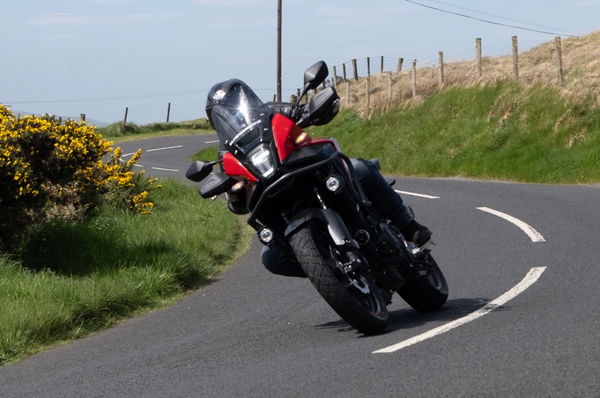First ride: 2018 MV Agusta Brutale 800 RR
Agusta's Brutale 800 RR hyper-naked is more refined, and more expensive, than ever

LIKE a slightly garish red-and-silver phoenix rising from the ashes, MV Agusta seems to be emerging from a financially troubling time with a fresh ethos, revised strategy and some exciting new technology.
Once again under the ownership of Giovanni Castiglioni, albeit this time with a 49 per cent stake in the hands of Russian tech giant, Timur Sardarov, the Italian manufacturer has cut its losses and realigned its priorities.
Now focussing on small batch production – churning out just 30 bikes per day from its factory in Varese, Italy – MV is pushing to the head of the premium motorcycle market, with exquisitely crafted, over-the-top machines.
I found out just how MV is upping its game on the launch of the new Brutale 800 RR.
Now, hopping on a 140hp motorcycle after just three hours’ sleep is never a good idea. But washout weather brought the press ride forward, which meant that after a 4am start (of course I’d left packing until midnight the night before) to catch my flight to Milan, I arrived in MV’s hometown just in time to ride that afternoon.
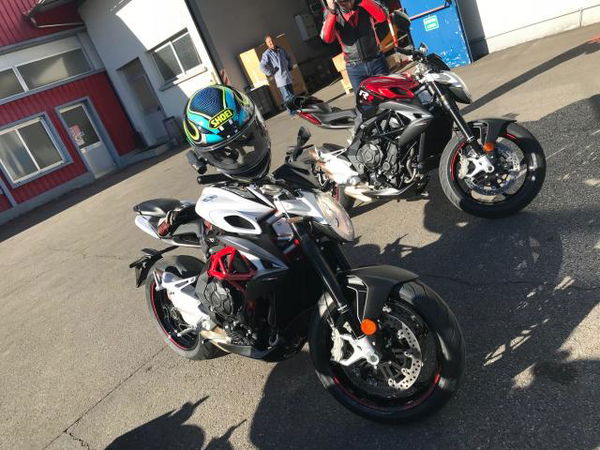
As it happens, the hyper-naked is a far better alarm clock than any iPhone could ever be. From the moment the powerful three cylinder comes to life you’re faced with an ultimatum. ‘Either wake up or get off’ it growls. I chose the latter, and what a ride!
The compact Brutale RR is as aggressive in style as it is performance. Based on the standard Brutale 800, which was last updated in 2016, its athletic, muscular appearance is accentuated by the red and white, or black and red graphic schemes and stunning diamond-machined forged aluminium wheels.
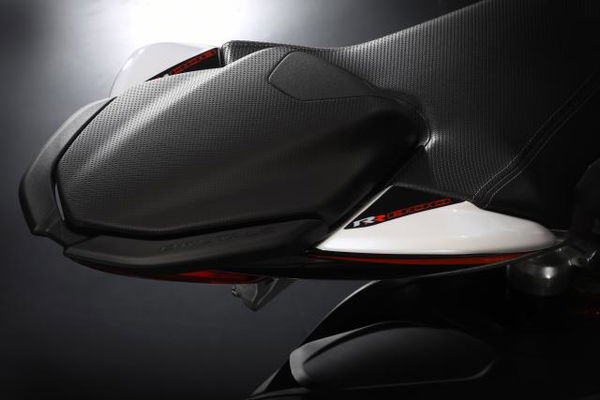
LED daytime running lights front up the bike, and a revised pillion seat, complete with stowable grab handles, shows the attention to detail that has gone into this model. Whether many passengers will willingly climb aboard the back of the Brutale remains to be seen…
The only questionable element of the bike for me is the swingarm-mounted numberplate holder, which hugs the rear wheel awkwardly. Of course, this is an EU compliance thing, and you could always swap it for a neat underseat unit, however the inclusion of the indicators down there may make that a little tricky.
But aftermarket tailtidys were pushed to the back of my mind as I climbed aboard the Brutale, its relatively tall seat height of 830mm and uncomfortable pew taking me by surprise. At 5’7”, I found myself precariously balancing the 175kg, £13,490 bike between my legs with only the balls on my feet in contact with the ground. But then again, easy-accessibility probably isn’t this beast’s USP.
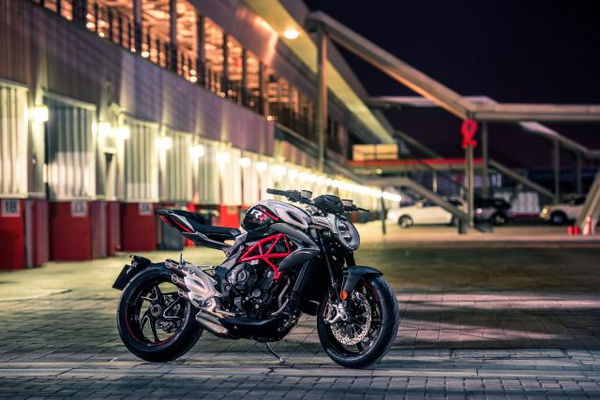
And as for the engine? Well firstly, MV is due hefty congratulations for making that potent powertrain Euro4 compliant without losing ANY power. That’s right, the 798cc unit makes exactly the same as its previous guise – 140hp and 64lb-ft at 10,100rpm.
To put that into perspective, from Euro3 to Euro4, MV was faced with the challenger of reducing exhaust emissions by 56 per cent and noise by 51 per cent. Interestingly, the latter reduction was achieved by identifying and minimalising mechanical noise – there’s even a specially designed ‘harmonic damping bolt’ in the cylinder heads.
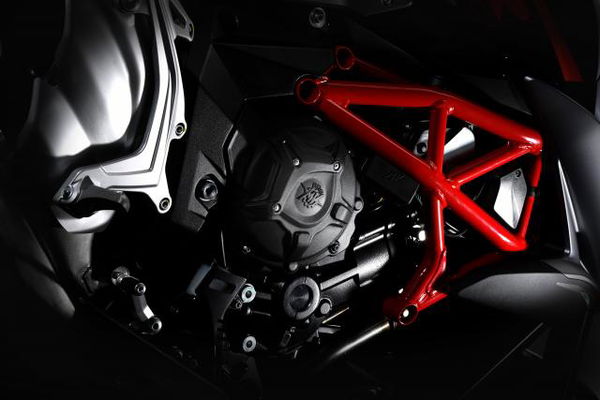
However, lack of change most certainly doesn’t mean lack of development. In fact, this unit is leagues ahead of its predecessor when it comes to refinement. Revised fuelling makes for incredibly fluid acceleration, with a much smoother torque curve at lower revs than before and a very linear power curve. It’s far more aggressive than the engine in the standard Brutale, making around 40 per cent more power, thanks to revised cams and different throttle bodies with twin injectors.
Whereas before the front of the engine was mounted on one long bolt, which behaved a bit like a spring, it is now directly anchored to the steel trellis frame, acting as a stressed member and improving torsional rigidity.
An altered primary transmission and new gearbox leaves the warranty issues of the previous guise in the past, and the quickshifter is arguably one of the best I’ve ever used. Less force is required to shift gears – great news for me as I’m notoriously light on the toe taps – and both upshifts and down blips are incredibly fast and smooth. Even shifting in corners doesn’t phase the bike, and it’s so easy to become addicted to the quickshift function.
“Use the quickshift for 10 minutes, and you’ll forget all about the clutch lever,” an MV mechanic had instructed as we set off. He wasn’t half wrong!

Meanwhile, there’s a new ECU and ride by wire throttle, which makes for an immediate and precise response at the slightest twist of the throttle, with no lag whatsoever.
It’s still got the four riding modes of Normal, Rain, Sport and Custom. You can switch between these fairly easily via the right handlebar while on the go, however in-depth Custom adjustment is done via the left and requires a little more attention.
Even in ‘Normal’ mode, the Brutale RR is livelier than Ant McPartlin in the Saturday Night Takeaway hospitality suite, with the acceleration forcing you to the back of your seat. It’s in its element at high revs, and from the moment you pull away, just keep the revs creeping up to get the best from the engine and rejoice at its tuneful soundtrack.
Set it to Sport mode and it picks up considerably – you better brace your feet against the sporty-positioned footpegs and hold on for dear life as the front wheel threatens to hop off the ground.
And if you do want to get that front wheel up, switch to Custom mode, where a breadth of adjustability allows the rider to change just about everything – including traction control, gas sensitivity, torque, engine braking, rev limit and engine response. Set the eight-level traction control to ‘2’ and prepare to clench as the front wheel will come up on just the power.
Now, way back in 2012 MV Agusta introduced its innovative counter-rotating crankshaft to the F3 series – making history as the first manufacturer to bring the MotoGP technology to the street.
The clever crankshaft worked to cancel out the rear wheel inertia, improving chassis handling and allowing the bike to make extremely quick directional changes. The engine in the new Brutale 800 RR is an evolution of the F3 800 powertrain, and that crank is still there, albeit refined over the years.
Combined with the compact chassis dimensions, this makes the Brutale incredibly agile. You can turn in on a dime and the bike reacts rapidly to even the most gentle of movements. At first, this ease of turning was disconcerting, however once I became accustomed to it I found myself pushing later and later before turning into bends.
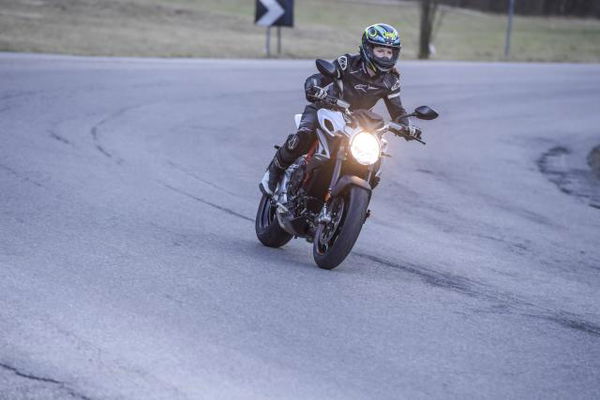
However, while the Brutale remains achingly agile, stability has been improved thanks to an increased wheelbase and altered rake and trail angles. Especially under heavy acceleration and high speeds, the Brutale RR feels planted and well balanced.
Pirelli Diablo Rosso IIIs proved excellent on Italy’s varied tarmac. When we made it out on to the road, it been slightly warmed by the weak winter sun, and the new tyres had no issue finding grip. While its partnership with Mercedes AMG is a thing of the past, in November 2017 MV announced a new partnership fellow Italian brand Pirelli, making it the sole tyre supplier for all their bikes. For £2,700 more (eek) than the standard 800 RR, Pirelli aficionados can opt for the special Pirelli edition, which feature unique colour schemes, components and a wider rear wheel.
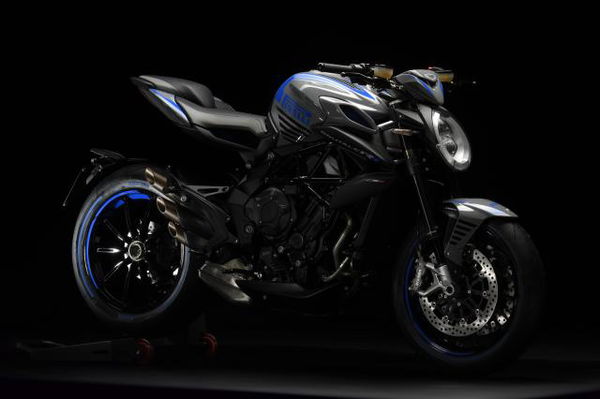
Suspension is taken care of by a Marzocchi inverted fork and Sachs shock, both of which are adjustable for spring preload, and compression and rebound damping. In its standard set up, the suspension is incredible capable, and as would be expected, stiff and sporty. To truly be comfortable for my 56kgs, it would require a little softening, however the larger riders were not complaining.

An eight-position steering damper features atop the forks, however it seemed to make little difference to the bike’s handling. However, busy roads and strict speed limits meant that we couldn’t really test the new RR to its limits on launch, and the damper may show its true colours on track.
There’s a decent amount of vibration through the bars too, which made reading the dash and using the mirrors a little tricky, but that can be forgiven given the potency of the three-pot powertrain.
Brembo radial four-piston calipers grab twin 320mm discs up front, with enough bite to stop a bike twice the Brutale’s size (there’s a reason ‘Rear wheel Lift-up Mitigation’ features in the Bosch ABS 9 Plus system). A two-piston Brembo unit on a single disc features at the rear, providing not bad stopping power itself. Neither ABS nor traction control kicked in on our 80-odd mile test ride.
CLICK NEXT FOR VERDICT AND SPECS...
VERDICT
MV claim the new Brutale 800 RR was three years in the making, but it feels a generation ahead of the mass-production models of the manufacturer’s previous life.
It combines excellent lightweight handling with the power of a fully grown naked. Forget the term middleweight, as the 800 RR occupies a grunty league of its own.
Costing from £13,490, the Brutale 800 RR is also in a different price league to its competition. Triumph’s Street Triple RS costs from £10,100, while KTM’s 790 Duke is £8,499 and Yamaha’s MT-09 SP is only £500 more at £8999. Admittedly they’re lower powered and less exclusive than the Brutale, but that aggressive spirit of riding remains.
Yes, the price has increased, but so has the bike’s reliability, attention to detail and fine craftsmanship. MV is aiming to be better than premium, and it looks like they’re nearly there. But only time will tell if the new Brutale will banish the breakdowns of its predecessor.
SPECS
Engine: Three cylinder, 4 stroke, 12 valve
Max power: 140 hp at 12.300 r.p.m.
Max Torque: 64ft lb at 10,100rpm
Transmission: six speed, chain drive
Frame: ALS Steel tubular trellis
Front suspension: Marzocchi upside down fork, preload/rebound/compression adjustable
Rear suspension: Sachs monoshock, preload/rebound/compression adjustable
Brakes: Brembo radial callipers on double discs, Brembo calliper on single disc
Wheels/tyres: Aluminium/Pirelli Diablo Rosso III
Dry weight: 175kg

